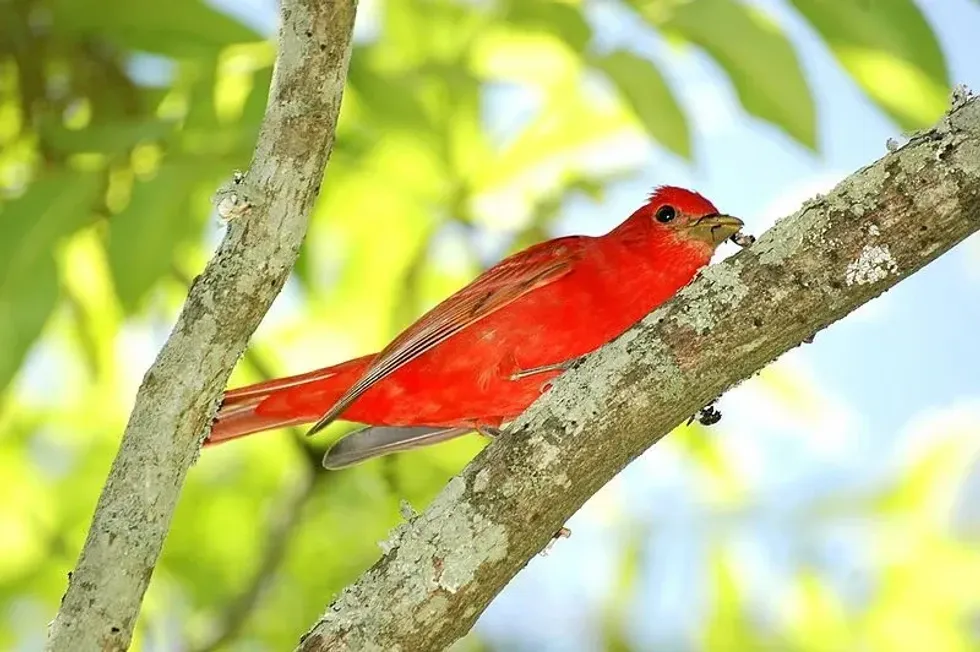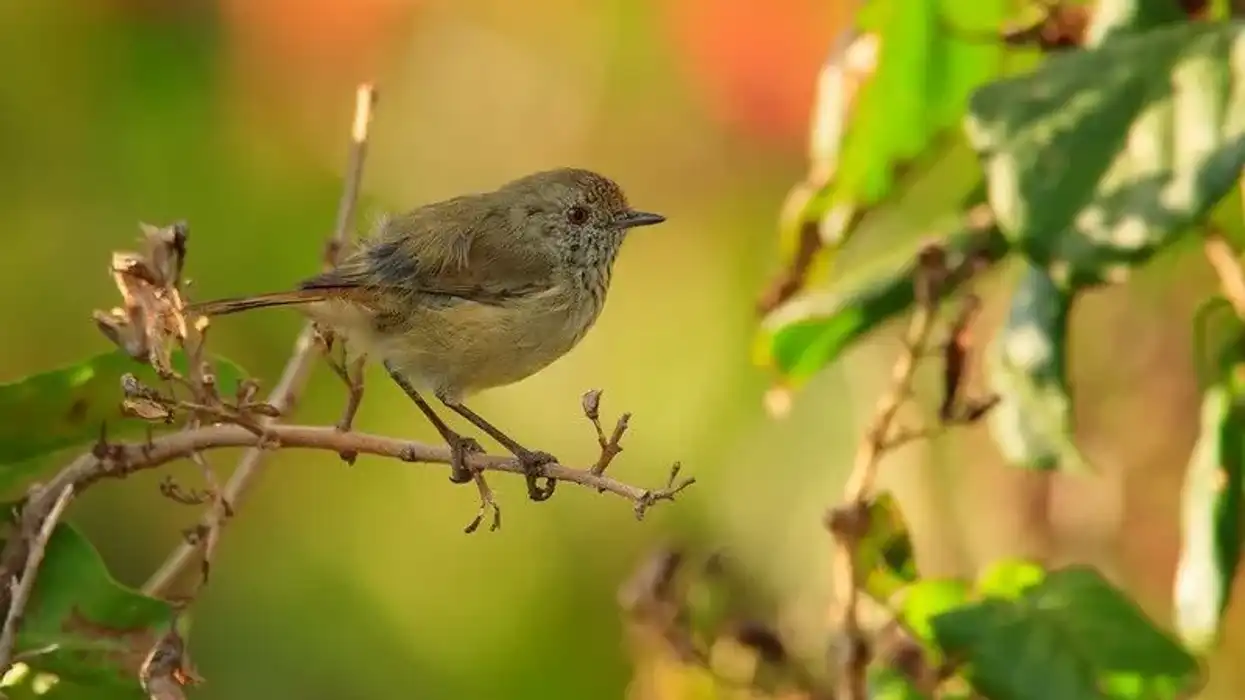Summer tanagers are a type of North American songbird commonly found in the U.S and Northern Mexico. They migrate to Central America and the middle of South America during winters.
These birds are further divided into two subspecies: Piranga rubra rubra and Piranga rubra cooperi. They are classified under Cardinalidae (the cardinal family).
Earlier, they were placed under the Thraupidae (the tanager family), but the species of this genus exhibit similar kinds of plumage and vocalizations to those of the Cardinalidae. Other species in this family are the scarlet tanagers, northern cardinals, western tanagers, and hepatic tanagers. They feed mainly on insects like beetles, bees, and wasps.
During the winter, migrating, or late breeding seasons, they are seen to consume fruits and berries as well. These birds are hard to spot on the treetops, especially while hunting for food, but they can be identified by their songs.
Summer tanagers (Piranga rubra) exhibit sexual dimorphism. While the adult male birds have completely red plumage, the breeding females have a yellow ventral part with green wings and tail.
The males are sometimes confused with scarlet tanagers due to their red plumages. They live in suburban and riparian habitats. These serially monogamous birds breed once annually.
The female incubates the eggs, and the male brings the food for them. The young ones, when ready to fledge, usually leave the nest after eight to 10 days and can fly after two or three days.
To know more about these fascinating animals, we have gathered a set of interesting facts about them for you to read. You can also read up more articles on geese and birds of paradise.
Summer Tanager Interesting Facts
What type of animal is a summer tanager?
Summer tanagers are North American birds. They are a type of songbird.
What class of animal does a summer tanager belong to?
Summer tanagers are birds and, therefore, belong to the class Aves.
How many summer tanagers are there in the world?
These birds are common and have a steady population in the U.S. According to Partners in Flight, globally, the estimated population of this bird is 12 million. Nevertheless, the decline in forest areas is contributing to the gradual decrease in their numbers.
Where does a summer tanager live?
In the United States, these birds are found in the eastern forests, open woodlands, and southwestern riparian areas, and in Mexico, they are found in the evergreen and deciduous forests. They prefer low elevations.
East Texas, east Oklahoma, California, and northern Mexico are included in their breeding range.
During migration in winter, they move to southern Central America and the middle of South America. During summers, this bird species can be found in Ohio River Valley, southern Missouri, southern New Jersey, southern New Mexico, and Arizona, and during winters, they can mainly be found in northern and central Mexico, Ecuador, and Brazil.
What is a summer tanager's habitat?
They are suited to temperate and tropical regions. Summer tanagers breed in cup-shaped nests made of dried grass and leaves built by the females.
Sometimes, the males help in gathering the materials for the nest. Usually, the nests are built far from the tree trunks, on horizontal branches of oak trees or cottonwood in the forests or riparian areas. The nests are abandoned after the eggs are hatched, and the fledglings leave the territory.
Who do summer tanagers live with?
Except during breeding and migration, they live alone. The male birds sing to defend their territories and chase any intruders away during the breeding season.
The fledglings leave the nest after eight to 10 days. They are taken care of by both parents for around three weeks after fledging. When migrating, summer tanagers are sometimes known to join mixed-species flocks.
How long does a summer tanager live?
They have a lifespan of four to six years. The longest lifespan recorded is seven years and 11 months for a male bird in Texas.
How do they reproduce?
Summer tanagers breed once annually. They are serially monogamous and the breeding season falls during April and August. The male bird courts the female by singing and chasing after them.
The females build shallow, cup-shaped nests and lay eggs soon after. There will be around three or four smooth, oval-shaped eggs per brood. The eggs are of pale blue or green color with brown spots.
The incubation period lasts 12-13 days and is done solely by the female. During this period, the male either rests or leaves the nest to find food to feed the female. Both parents feed the nestlings till they leave the nest and the territory.
What is their conservation status?
According to the International Union for Conservation of Nature (IUCN), these birds are listed under the status Least Concern. Even though they are protected under the US Migratory Bird Act, there are no immediate threats to the species.
Their overall population has remained steady despite local fluctuations. However, habitat loss is a threatening factor that can result in a gradual decrease in the population of these birds.
Summer Tanager Fun Facts
What do summer tanagers look like?

They are medium-sized birds with large, pale yellow blunt-tipped bills and a relatively large head. They are sexually dimorphic; that is, the male and female birds have differences in their physical appearance.
The adult males have bright strawberry-red plumage, while the females have a dull mustard-yellow lower part with olive-green wings. The female summer tanager slightly resembles a female scarlet tanager. The difference lies in the lack of a mustard-yellow lower part, blackish wings, shorter tail, and longer, grayish bill in the scarlet tanagers.
A juvenile summer tanager male looks similar to breeding females with patches of red. Both the male and female have dark eyes.
How cute are they?
These charismatic solitary birds of North America are not very social. They are somewhat shy but are definitely very cute with their pretty red or yellow plumage and clicking notes.
How do they communicate?
These birds use vocalizations and physical gestures to communicate. During the breeding season, a male summer tanager courts the female using its rich and musical song and by chasing it.
It competes with its rival male birds with a response song. While nesting, the male birds defend their territory by singing and chasing away the intruders.
Apart from the musical song, they also make use of several other notes while communicating. A summer tanager song is a bit similar to that of an American robin but shorter with three or four units of distinctive pi-ki-tuck pi-ki-tuck notes.
How big is a summer tanager?
With a mass of 1-1.4 oz (30-40 g) and a length of approximately 6.69 in (17 cm), these birds are considered to be of medium size. They have a wingspan of 11.02-11.81 in (28-30 cm). They are approximately half the size of an American robin. They are a little bigger than the American yellow warbler.
How fast can a summer tanager fly?
These are migrating birds, so they are known to store fat in order to fuel their flight during the migration period. Sometimes they can also fly in a distinctive way to be able to catch their prey mid-flight, but the estimate of their flying speed is not known as of now.
How much does a summer tanager weigh?
An average summer tanager bird weighs around 1-1.4 oz (30-40 g).
What are their male and female names of the species?
There are no distinct names for males and females. A bird of this species, whether male or female, is commonly known as a summer tanager (Piranga rubra). There is no specific name for a group of summer tanagers either.
What would you call a baby summer tanager?
A young baby summer tanager, in general, can be referred to as a chick, nestling, or fledgling.
What do they eat?
Summer tanagers are primarily insectivores during breeding as well as during winter. This means that these birds mainly eat insects.
Mostly, they feed on beetles, caterpillars, dragonflies, bees, and wasps. They hit their prey on the branches until they die and remove stingers before eating, but during their migration in winter, when insects are scarce, they also eat fruits and berries like bananas, blackberries and citrus. The parents feed their young until they fly the nest.
Are they friendly?
They are considered to be shy by nature even though they sometimes exhibit curiosity and come near humans. They are difficult to spot as they prefer foraging in the treetops and concealing themselves there.
Would they make a good pet?
No, they are not considered great pets. You can feed them in your backyard, but they are not accustomed to a household environment.
Did you know...
Summer tanagers can be attracted to your backyards if there are any fruit trees or berry bushes or if you provide them with treats like peanut butter or suet.
Some people believe that seeing this bird, in dreams, visions, or otherwise, is a symbol of joy, change, or peace.
One of the similar species to the summer tanagers is the Northern cardinals, who are a little larger than summer tanagers and have a long, pointed crest.
The scientific name of summer tanager, Piranga rubra, means a small red bird. Piranga, derived from Tijepiranga in Tupi, means a small bird, and rubra, derived from rubber in Latin, means red. They are also known as bee birds because of their food habit.
In French, summer tanagers are called Piranga vermillon, and in Spanish, they are called Piranga roja.
How do summer tanagers kill their prey?
These birds prefer foraging on treetops. They either catch them or pick them up from branches.
They attack the hives of wasps and chase them out so as to eat the larvae. Before consuming, the insects are beaten against the branches until they die. In the case of stinging insects, the stingers are removed first by rubbing on the branches and then consumed.
What are the differences between eastern and western summer tanagers?
The eastern and western populations are different in terms of physical appearance and nesting. These two populations are the eastern subspecies, Piranga rubra rubra, and the western subspecies, Piranga rubra cooperi.
The western subspecies generally have a paler plumage and longer wings, limbs, and tails. They also make a sturdy, rigid nest during breeding, whereas the eastern subspecies make a flimsy, see-through nest in which the eggs are visible from below.
Here at Kidadl, we have carefully created lots of interesting family-friendly animal facts for everyone to discover! Learn more about some other birds, including parrots and blue and yellow macaws.
You can even occupy yourself at home by drawing one of our summer tanager coloring pages.










